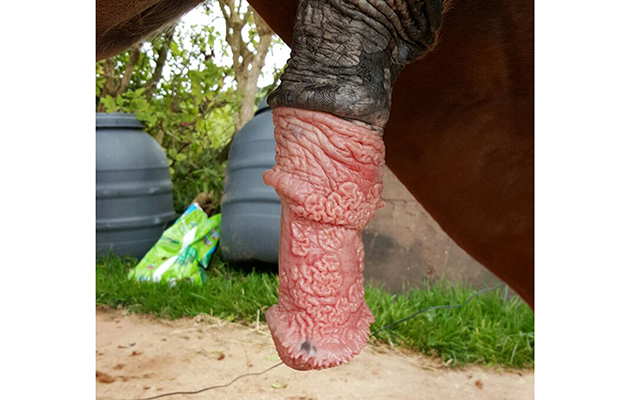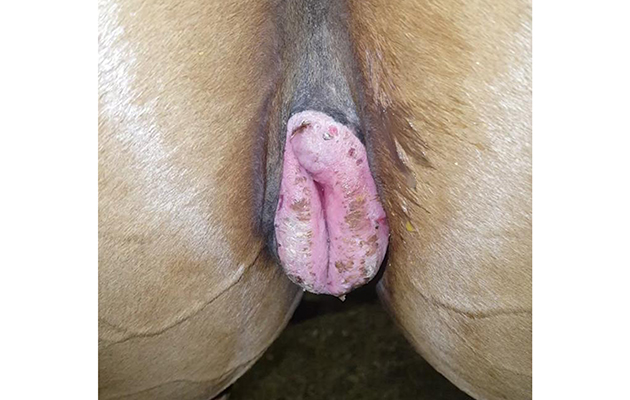Harrie looks like a typical gelding, until he has a pee. The 16-year-old Dutch warmblood then lifts his tail up and out of the way and urinates backwards, mare-like, from between his hindlegs.
On closer inspection, Harrie’s sheath is permanently sealed. There’s no evidence of a penis, just a small, neat opening further back — where there wouldn’t normally be one. This unusual arrangement is the result of surgery performed when pre-cancerous masses on Harrie’s genitals failed to clear up with medication.
His owner, Natasha-Jade Frith-Williams, noticed something amiss 18 months ago when she was giving him his first clip of the winter season.
“He had been lightly sedated,” she explains. “As his sheath relaxed and his penis dropped, I took the opportunity to clean it.
“It was when I’d washed off the grime that I found some pronounced lumps and bumps, from the base of his penis to the shaft [pictured, below],” adds Natasha, who was also alarmed by the serrated edge around its tip — definitely not something she’d seen before.

Natasha’s vet suspected a “papillomatous reaction” caused by viral infection, a skin condition that is harmless in the early stages but can become cancerous. A biopsy was recommended, so various parts of poor Harrie’s penis were “punched” with a special tool and sent for testing.
While results confirmed that the lumps were not yet cancerous, Harrie was started on a course of fortnightly treatment with chemotherapy cream.
“We could see an improvement after two treatments — the lumps were disappearing,” says Natasha. “It was a relief to think the problem might be manageable before it became aggressive. But Harrie hated the treatment and would turn away with his ears back when I went in his stable.
He was difficult to catch in the field, too, which is not like him.”
After the fifth treatment, Harrie’s penis appeared lumpier and blood-stained. Natasha’s vet suspected that he was becoming resistant to the chemotherapy.
“We had one more go with the cream, but new masses were developing further up in the sheath pocket,” says Natasha. “The chemo was causing him such distress that it was heartbreaking, but if we stopped the treatment there was a good chance that the masses would become cancerous. All I wanted was to do the right thing by Harrie, so I agreed that he should be referred to hospital for possible surgery.”
The kindest cut
In March last year, Harrie made the three-hour journey from his yard in the Lake District to Philip Leverhulme Equine Hospital at the University of Liverpool.
Surgeon Dr Luis Rubio Martinez (assisted by Resident in Equine Surgery, Anna Ehrle) considered his case carefully.
“Harrie’s penis shaft and glans [head] were affected by multiple masses, which did not seem to be responding to treatment with medication,” explains Luis. “The best option would be to amputate the shaft. You can cut the outer tissue to lift and remove the masses, depending on how deep they go, but these penetrated deep into the shaft. There was no point in removing just the surface.”
Amputation can take one of two forms. If the masses are on the end of the penis, a partial phallectomy may be sufficient — removing just the tip to leave a stump. Multiple, extensive and deep masses may require a more complex operation called “en bloc resection and penile retroversion”, which involves removing a greater part of the shaft and sheath sac before diverting the urinary tract to a different site.
Until Harrie was on the operating table, Luis would not know which of the two procedures would be necessary.
“Cancerous cells can travel from the masses up into the two big lymph nodes high in the groin area,” says Luis, explaining that these advanced cases usually require the more drastic surgery.
On the day of the operation, Natasha waited nervously for news.
“Luis rang me to say that while cells were visible on Harrie’s penis shaft, his lymph nodes were normal when palpated,” she recalls. “But there was no time to dither. I told him to go ahead with the full amputation — I wanted to give Harrie the best possibility of the longest, healthiest life.”
However, the complicated anatomy of the area makes surgery challenging.
“There are quite a few structures to isolate,” says Luis. “Excessive bleeding is a risk, so each of the multiple blood vessels must be tied off and secured.
“Once the shaft of the penis is removed, the stump is bent backwards,” he explains. “We then open a hole at the back, between the horse’s hindlegs, and feed the stump through this to create a way for the horse to pee [pictured, below].

“The stump is bent 180 degrees but not twisted or rotated, as this would compromise the outflow of urine. We align it so that urine flows straight out backwards, not to the side or too high or low. The front side is then closed and sutured.”
Road to recovery
After surgery, Harrie’s condition was closely monitored.
“We wanted to make sure that things were healing well and that he had no problem passing urine,” says Luis. “There’s often a bit of bleeding at first and some tension around the stitches, so we give the patient antibiotics, anti-inflammatories and painkillers.”
Harrie recovered well. He returned home a fortnight later, spending four weeks on box rest before being allowed to graze for short periods in a tiny paddock.
His wounds healed, but how did he adjust to a new way of urinating?
“At first he stood forwards, like a boy, and didn’t move his tail,” says Natasha, who washed his legs frequently to prevent urine scalding. “But he must have had a lightbulb moment as he now lifts his tail up and out of the way.
“You wouldn’t know otherwise that there was anything different about him,” she added. “I started exercising him in the autumn, a year after I first spotted the problem, and at Christmas we won a little jumping class.
“I’m just so glad that he is back to his cheeky self.”
Ref Horse & Hound; 8 June 2017
